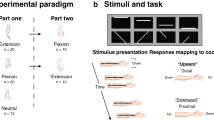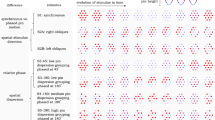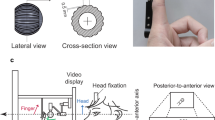Abstract
The perceived size of objects touching different regions of skin varies across the body surface by much less than is predicted from variations in tactile receptor density. Here we show that altering the visual experience of the body alters perceived tactile distances. We propose that the brain attempts to preserve tactile size constancy by rescaling the primary, distorted body-surface representation into object-centered space according to visual experience of the body.
This is a preview of subscription content, access via your institution
Access options
Subscribe to this journal
Receive 12 print issues and online access
$209.00 per year
only $17.42 per issue
Buy this article
- Purchase on Springer Link
- Instant access to full article PDF
Prices may be subject to local taxes which are calculated during checkout



Similar content being viewed by others
References
Weber, E.H. The Sense of Touch (H.E. Ross & D.J. Murray, trans.) (Academic, London, UK, 1978).
Weinstein, S. in The Skin Senses (ed Kenshalo, D.R.) 195–218 (Thomas, Springfield, IL, 1968).
Kurth, R. et al. NeuroReport 11, 1487–1491 (2000).
Green, B.G. Percept. Psychophys. 31, 315–323 (1982).
Paillard, J., Michel, F. & Stelmach, G. Arch. Neurol. 40, 548–451 (1983).
Kennett, S., Taylor-Clarke, M. & Haggard, P. Curr. Biol. 11, 1188–1191 (2001).
Penfield, W. & Rasmussen, T. The Cerebral Cortex of Man: a Clinical Study of Localization of Function (Macmillan, Oxford, UK, 1950).
Boring, E.G. Am. J. Psychol. 77, 494–498 (1964).
Marr, D. Vision (W.H. Freeman, San Francisco, CA, 1982).
Calford, M.B. Neuroscience 111, 709–738 (2002).
Recanzone, G.H., Merzenich, M.M., Jenkins, W.M., Grajski, K.A. & Dinse, H.R. J. Neurophysiol. 67, 1031–1056 (1992).
Ramachandran, V.S. & Rogers-Ramachandran, D. Arch. Neurol. 57, 317–320 (2000).
Gandevia, S.C. & Phegan, C.M.L. J. Physiol. (Lond.) 514, 609–616 (1999).
Graziano, M.S.A. Proc. Natl. Acad. Sci. USA 96, 10418–10421 (1999).
Iriki, A., Tanaka, M. & Iwamura, Y. NeuroReport 7, 2325–2330 (1996).
Acknowledgements
Supported by the Engineering and Physical Sciences Research Council (M.T.C.), and a Leverhulme Trust research fellowship (P.H.). We thank J. Woodhouse, S. Kennett and D. Wolpert for advice and support.
Author information
Authors and Affiliations
Corresponding author
Ethics declarations
Competing interests
The authors declare no competing financial interests.
Supplementary information
Supplementary Fig. 1
Bias in tactile distance judgment before and after viewing an enlarged video image of the hand. (JPG 31 kb)
Rights and permissions
About this article
Cite this article
Taylor-Clarke, M., Jacobsen, P. & Haggard, P. Keeping the world a constant size: object constancy in human touch. Nat Neurosci 7, 219–220 (2004). https://doi.org/10.1038/nn1199
Received:
Accepted:
Published:
Issue Date:
DOI: https://doi.org/10.1038/nn1199
This article is cited by
-
Apparent increase in lip size influences two-point discrimination
Scientific Reports (2023)
-
The distorted hand: systematic but ‘independent’ distortions in both explicit and implicit hand representations in young female adults
Experimental Brain Research (2023)
-
Tool-use training in augmented reality: plasticity of forearm body schema does not predict sense of ownership or agency in older adults
Experimental Brain Research (2023)
-
No evidence for sex differences in tactile distance anisotropy
Experimental Brain Research (2022)
-
Perception of body shape and size without touch or proprioception: evidence from individuals with congenital and acquired neuropathy
Experimental Brain Research (2021)



